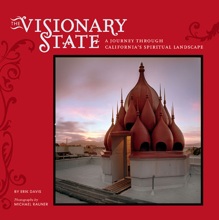Wishlist: The Visionary State: A Journey Through California's Spiritual Landscape


Arriving in Marin County, (New York poet Elsa) Gidlow holed up in a derelict house in rural Fairfax. She was forty years old. Facing winter solstice alone and unsettled, she decided to perform what she later described as a "transforming ritual." As a storm raged outside the leaky house, she built up a roaring blaze of madrone logs. Slowly, Gidlow sensed the room fill with the spirits of all the mothers and grandmothers who have ever tended fire, all the way back to the Paleolithic. "I knew myself linked by chains of fire," she wrote, "to every woman who has kept a hearth." In the morning, Gidlow honored this rather neo-pagan vision by wrapping some of the cold coals in foil and red ribbon, and keeping them for next year's solstice fire.
In 1954, Gidlow brought one of these solstice charcoals to her new home, a junky five-acre patch of rural hillside on the edge of Muir Woods, lying at the end of a precarious road more clay than dirt. Shadowed by a looming wall of eucalyptus to the southwest, a few tumble-down frame houses and barns were already returning to earth, and there was no plumbing to speak of. Gidlow dubbed the place Druid Heights, and it would soon blaze into a hidden hearth of bohemian culture, a "beatnik" enclave years before the term was born or needed, and later a party spot for famous freaks. Scores of sculptors, sex rebels, stars and seekers lived or visited the spot over the decades, including Gary Snyder, Dizzy Gillespie, John Handy, Alan Watts, Neil Young, Tom Robbins, Catherine McKinnon and the colorful prostitute activist Margo St. James. Too anarchic and happenstance to count as a commune, Druid Heights became what Gidlow jokingly called "an unintentional community:" a vortex of social and artistic energy that bloomed out of nowhere, did its wild and sometimes destructive thing, and, for the most part, moved on.
In 1954, Gidlow brought one of these solstice charcoals to her new home, a junky five-acre patch of rural hillside on the edge of Muir Woods, lying at the end of a precarious road more clay than dirt. Shadowed by a looming wall of eucalyptus to the southwest, a few tumble-down frame houses and barns were already returning to earth, and there was no plumbing to speak of. Gidlow dubbed the place Druid Heights, and it would soon blaze into a hidden hearth of bohemian culture, a "beatnik" enclave years before the term was born or needed, and later a party spot for famous freaks. Scores of sculptors, sex rebels, stars and seekers lived or visited the spot over the decades, including Gary Snyder, Dizzy Gillespie, John Handy, Alan Watts, Neil Young, Tom Robbins, Catherine McKinnon and the colorful prostitute activist Margo St. James. Too anarchic and happenstance to count as a commune, Druid Heights became what Gidlow jokingly called "an unintentional community:" a vortex of social and artistic energy that bloomed out of nowhere, did its wild and sometimes destructive thing, and, for the most part, moved on.


Comentários